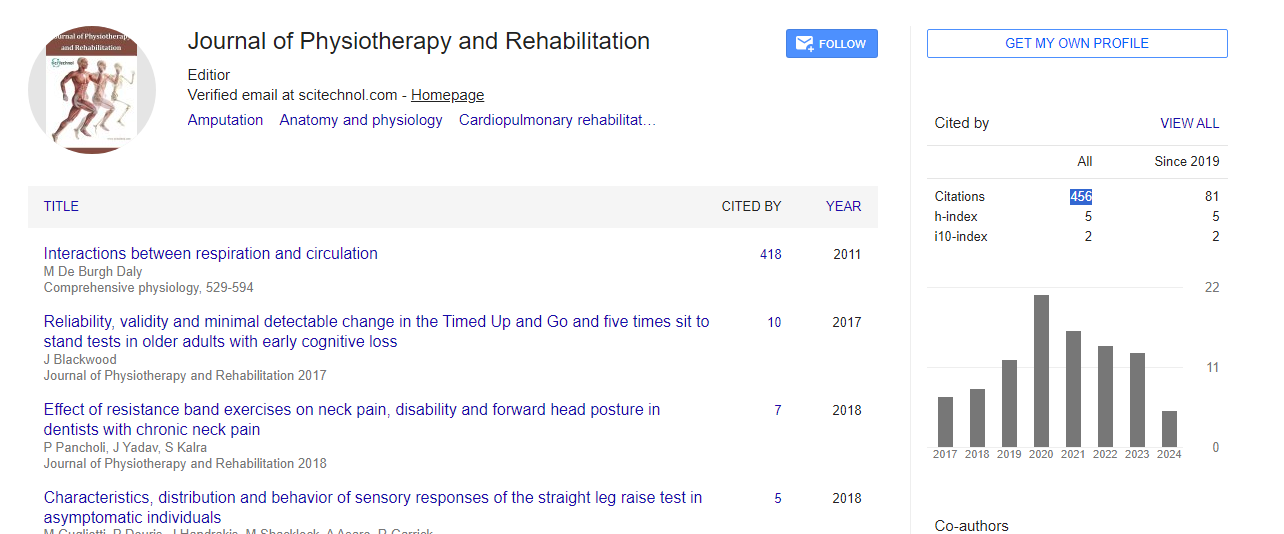Perspective, J Physiother Rehabi Vol: 8 Issue: 5
Challenges and Opportunities in Rehabilitation for Children with Spina Bifida
Ethan Kapoor*
1Department of Rehabilitation, Mayo Clinic College of Medicine, Rochester, United Kingdom
*Corresponding Author: Ethan Kapoor,
Department of Rehabilitation, Mayo Clinic College of Medicine, Rochester, United
Kingdom
E-mail: kapooretha@n.uk
Received date: 24 September, 2024, Manuscript No. JPTR-24-151638
Editor assigned date: 26 September, 2024, PreQC No. JPTR-24-151638 (PQ);
Reviewed date: 10 October, 2024, QC No. JPTR-24-151638
Revised date: 17 October, 2024, Manuscript No. JPTR-24-151638 (R);
Published date: 24 October, 2024, DOI: 10.4172/JPTR.1000182.
Citation: Kapoor E (2024) Challenges and Opportunities in Rehabilitation for Children with Spina Bifida. J Physiother Rehabi 8:5.
Description
Rehabilitation for children with Spina Bifida presents unique challenges and significant opportunities that impact their physical, social and cognitive development. Spina Bifida is a congenital condition affecting the spine and spinal cord, leading to varied mobility limitations and neurological impairments. These challenges require customized rehabilitation approaches that cater to each child’s individual needs while also addressing broader aspects of well-being. Early intervention is essential in managing Spina Bifida, helping to improve the child’s quality of life and independence. However, the complex nature of the condition necessitates multifaceted therapeutic strategies that address motor skills, mental health and social inclusion.
One of the primary challenges in Spina Bifida rehabilitation is managing mobility limitations. Many children with Spina Bifida experience difficulties with walking and require assistive devices, such as braces, crutches or wheelchairs, to move around. Physical therapy is fundamental to rehabilitation, as it focuses on strengthening the muscles, enhancing motor skills and encourages independence in daily activities. However, children with higher levels of spinal involvement often face considerable mobility restrictions, necessitating lifelong support and adaptations. The intensity and duration of physical therapy required can be challenging for both children and their families, particularly as the child grows and new motor skills become necessary to support their increasing independence.
Another major challenge is neurocognitive development. Children with Spina Bifida often face cognitive impairments, particularly when the condition is accompanied by hydrocephalus, a buildup of fluid in the brain. These cognitive challenges can affect memory, attention and executive functioning, making learning and academic achievements more difficult. Rehabilitation efforts for children with Spina Bifida should include cognitive therapy to support their mental development and adaptive skills. Special education and learning accommodations can also provide additional support for these children in school settings. Psychosocial well-being is another critical aspect of Spina Bifida rehabilitation. Children with this condition may experience feelings of isolation or frustration due to their physical limitations, impacting their mental health. Rehabilitation must, therefore, include counseling and peer support opportunities to help children manage their emotions and encourage positive self-esteem. Encouraging peer interactions through inclusive recreational activities, such as adapted sports or art programs, can provide a sense of belonging and help reduce feelings of isolation. Family involvement in the rehabilitation process is also essential. Parents and caregivers often require guidance on how best to support their child’s physical and emotional needs.
While there are significant challenges in rehabilitating children with Spina Bifida, there are also numerous opportunities for improvement. Advances in medical technology and research have led to improved therapeutic interventions and devices that enhance mobility and independence for these children. Robotics and virtual reality are emerging as potential tools in physical therapy, providing engaging and effective ways to practice motor skills and build strength.
Conclusion
Rehabilitation for children with Spina Bifida involves overcoming various physical, cognitive and social challenges. However, with early intervention, family support and emerging therapeutic innovations, there is immense potential to improve their quality of life. By addressing each child’s unique needs and empowering them with adaptive skills, rehabilitation can encourage independence, flexibility and a more inclusive future.
 Spanish
Spanish  Chinese
Chinese  Russian
Russian  German
German  French
French  Japanese
Japanese  Portuguese
Portuguese  Hindi
Hindi 